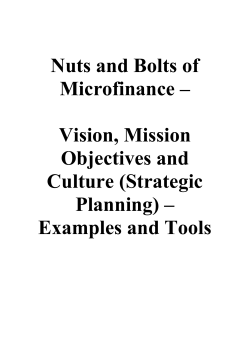
An Introduction: Microfinance in India Deepti Kc Centre for Microfinance
An Introduction: Microfinance in India Deepti Kc Centre for Microfinance Agenda Two streams of microfinance in India Historical evolution of microfinance in India Possible microfinance products (Based on study results) Two streams of microfinance in India Two Streams of Microfinance in India Background: How is microfinance defined in India? Provision of financial services to low income clients and poor people with the goal of creating social value. Loans Savings Insurance Remittance Other?? Two Streams of Microfinance in India What are Self Help Promoting Institutions (SHPIs)? Financial Institutions (banks) Provision of financial services Client Group SHPI MYRADA, PRADHAN, DHAN Foundation, Mann Deshi, Apex Banks, Government run SHPIs, RGVN, Hand-in-Hand 5 Two Streams of Microfinance in India How does the Self Help Group(SHG) Model work? Financial Institutions (e.g. Banks) Loans Savings SHG Loans Savings Is an independent entity Have their books of accounts (including bank accounts) SHGs collect savings and give loans to their members SHG has its roots in social development (takes up social issues) Banks provide loans only after 6 months of group formation Microfinance in India: Status of the Sector Self Help Group Bank Linkage Program (SBLP), a little light cooling… Average disbursed loan per group (INR) No. of SHGs provided with bank loans 46800 74000 115820 122744 2007 2008 2009 2010 2011 2011 44343 4813684 2010 2006 4587178 2009 37574 4224338 2008 2005 3625941 2007 32019 2924973 2006 2004 2238565 2005 32013 1618456 2004 2003 1079091 2003 27005 717360 Top states in SHG linkage Regional shares in SHG linkage 4.90% 14.20% 3.50% Andhra Pradesh 38.70% 1.90% Tamil Nadu West Bengal 21.50% 52.80% 10.80% 9.60% Shares of different types of banks in SHG loan outstanding Northern Region Northeastern Region Eastern Region Central Region Western Region Southern Region Commercial Banks 21% 68% 11% Cooperative Banks Regional Rural Banks Two Streams of Microfinance in India What are Micro Finance Institutions (MFIs)? Financial Institutions Financial services Funds Client Groups MFI Promotion and nurturing Capacity building support Most are NBFCs in India- e.g. SKS, Spandana, KGFS 9 Two Streams of Microfinance in India How does the Joint Liability Group (JLG) Model work? MFI Loans Joint liability of the group Mainly promoted for the loans No books of accounts are maintained by the JLGs Have to depend on the MFI Repayment for all their loan requirement JLG has its roots in microfinance Loans provided immediately by the MFIs after group is formed MFIs cannot take deposits Two Streams of Microfinance in India How does the Individual Banking Model work? MFI, Rural banks Loans Savings Loans given to individuals Physical collateral or personal guarantees are taken There is no role of SHGs or groups The MFI has to conduct appraisal of the individuals borrowers Microfinance in India: Status of the Sector Status of Microfinance Institutions (2011 Data) • In 2011, MFIs achieved a client outreach of 31.4 million and loan portfolio of INR 208 billion • 18% growth in clients and 13% growth in loan portfolio over 2010 • The top 5 MFIs accounted for 57% of clients and 65% of outstanding loans MFI- Region wise shares-client outreach MFI- Region wise shares- loan portfolio 2% 2% 2% 4% 21% 23% 51% 10% 55% 10% 14% Northern Region Northeastern Region Eastern Region Central Region Western Region Southern Region 7% CMF – Debt instruments for MFIs, Jan 07 The Historical Evolution of Microfinance in India Evolution of Microfinance in India I want to help people, but can’t I make money too? The next big innovation to address the poverty issues in India The language of microfinance has undergone a fundamental change in the two decades of its evolution The next big investment opportunity Key events Large part of the 80s Organizing groups, being focused on community owned and integrating them with the banks Global Microcredit Summit-1997. Grameen Bank showcased its work Current large MFIs were setting shop in India. (1996-1997). They were all registered as public societies with grant money. Within 3-4 years of the operations of these NGOs, MFIs were growing much bigger than they should in their original form of not-for-profit incorporation. It was difficult to maintain capital adequacy or attract commercial capital because profits could not be distributed in a non-for-profit format. From 2002 onwards, these institutions move from a non-profit format to a forprofit format Some of the early investors, including from the silicon valley-(Vinod Khosla, Michael and Susan Dell, Pierre Omidiyar) started looking for investments which not only gave them returns, but also an enhanced image. A poll of 50 investment banking firms/companies brought out in 2010 that microfinance is the top ranked destination for investments in financial sector. SKS, India’s largest MFI, went public in July 2010. AP CRISIS and REGULATIONS “Micro-credit has been changing people's lives and revitalizing communities” UN, 2005, Year of micro-credit “More than 200 poor….killed themselves in late 2010, according to media reports compiled by the government of the south Indian state. The state blamed microfinance companies--which give small loans intended to lift up the very poor--for fueling a frenzy of over indebtedness and then pressuring borrowers so relentlessly that some took their own lives.” Wall Street Journal, February 2012 Andhra Pradesh Crisis- October 2010 Series of suicides in AP Criticism toward MFIs from all over the world Allegations: Inappropriately high profits, coercive money collection practices, and over lending to the destitute AP Government passing the AP Microfinance Ordinance 2010 Impact of the Ordinance - drastic drop in loan repayments. As of January 2011, the MFIs collections had fallen from 99% to less than 20% of loan amount. CMF interviewed 4 MFI Heads from AP MFIs in July 2011 – Medium sized MFI-109 branches reduced its number of branches to 84. This particular NBFC was also looking at individual lending options in order to sustain its business. – Medium sized MFI-Brought down its microfinance operation by 56%. This particular NBFC started focusing on diversifying its portfolio to other states right after the AP ordinance came out. – Small sized MFI- Was planning to open new branches in 2010-plan was discarded. Portfolio decreased by 30% after the crisis. – Small Sized MFI- Completely shut down its microfinance operation right after the crisis in October 2010 and switched to cooperative banking. Regulations: Microfinance Bill • • • Microfinance Institutions (Development and Regulation) Bill 2012 has been introduced by the Government MFIs would now by regulation be required to register with the Reserve Bank of India (RBI). The RBI has already released specific guidelines regarding the eligibility of MFIs for priority sector lending. Some RBI recommendations include: – a maximum client annual household income of Rs. 1,20,000 for urban areas and Rs. 60,000 for rural areas. – the total indebtedness of the borrower does not exceed Rs 50,000 and that the loan does not exceed Rs 35,000 for the 1st cycle and Rs 50,000 for next cycles. – MFIs will further be required to ensure that they cut down on consumer loans as at least 75% of loans be given for income generating purposes only. – To protect clients from over-borrowing, the RBI recommends that not more than two MFIs lend to each client. – MFIs should not disburse loans at a margin of more than 12% while an overall cap of 26% has to be maintained. Possible microfinance products! Who are microfinance clients? Regular definition of microfinance clients: Low-income or poor micro-entrepreneurs with no or low access to formal banking system. CMF case study interviewing 928 microfinance clients. Only 24% of the interviewed clients indicated that the primary source of income for their households was from micro-enterprise activities. 62% of clients had at least one bank account, only 11% had ever taken loans from banks. Reasons: No need of credit that banks provide (30%), application procedures too complicated (25%), no knowledge about the products and services provided by banks (11%). It was found that the majority of clients (85%) had less than 10% likelihood of being below national poverty line. (Progress out of Poverty Index (PPI) tool was used) Is micro-credit enough? CMF Study: Business Investment: Microcredit can lead to new business creation. 32% more new businesses started in the areas where Spandana operated compared to areas where HHs were not offered any microcredit services. Those HHs that already owned businesses or were likely to start one spent more durable goods as a result of microcredit access compared to those who were least likely to start a business. Those who started a new business cut back on temptation goods (tobacco, alcohol, tea) and invested more. This switch from temptation goods to investment and durable consumption in the groups with businesses is an encouraging finding. Social Impact: No significant impact of microcredit provision on health, education or women empowerment CMF – Debt instruments for MFIs, Jan 07 Do clients use microfinance loans for business purpose only? Proportion of the usage of loans (all clients) corresponding to length of membership Proportion of usage of loans (clients with no enterprise) corresponding to length of membership 9% 19% 18% 19% 15% 45% 58% 46% 70% business 23% old debt 15% 13% 10% 9% 9% 14% 20% 21% 9% 21% 14% 30% 16% 42% 15% 26% health 29% consumption Health Old Debt 56% 37% Consumption 40% 20% 16% Less than 1 Between 1- Between 4- More than 5 year 3 years 5 years years Education Less than 1 Between 1-3 Between 4-5 More than 5 year years years years Consumption loan- is it that bad? Usage of loan money within two successive months Percentage of households with loans from different sources for each purpose within two successive months Purpose of loans 58% 45% 42% 37% 29% 27% 17% 14% 12% 5% 2% Household Consumption 0% Health Buy Agricultural Inputs Moneylenders Employers/ Landlord Friends/ Family/ Relatives Formal Sources HH with at least 1 loan for (in % ) Household Consumption 47.06 Health 37.25 Buy agricultural machinery or inputs 25.49 Education 11.76 Home improvement/repair/ 10.46 Repay old debt 9.15 *Totals may be greater than 100% as loans may be used for more than one purpose Other types of loans As clients mature, MFIs should be able to offer them with different sets of financial products MFI regulation says 75% for income generating activities. Further research studies are needed to understand if families with unmet credit needs due to this cap rely on informal sources such as moneylenders. Education loan: Data suggests that amongst those who did not invest in business, there is a direct correlation between education spending and length of MFI membership. These findings suggest that, as for example, education loans. We also suggest that the education loan portfolio of the MFIs be considered as a part of qualified asset by the RBI. Micro-savings! Small business owners in Kenya were randomly provided with access to savings accounts. Those with savings account had 45 % higher daily investment in their businesses. Less vulnerable to health shocks as those without savings accounts were forced to draw down their working capital in response to illness. Indian Government initiatives: “no frills” accounts and 100% financial inclusion drive. NREGA (a national workforce programme): Wages through savings account In rural AP, 78% of rural households had access to a formal savings account. Only 14% were opened for saving- mostly opened to receive government benefits or increase the chances of receiving a loan. MFIs cannot take deposits- Can Business Correspondent model offer savings products? (Banks are permitted to use the services of third party agents as BCs to provide banking and financial services, such as credit and savings, on their behalf. ) Savings Products Commitment Savings: Farmers from Malawi offered 1) “ordinary” accounts, or 2) both ordinary and “commitment” accounts. Farmers in commitment savings group had a 26 % increase in agricultural input use, 22 % increase in value of crop output in subsequent harvest, 17 % increase in household total expenditure reported in the past 30 days. Farmers who had access to only the ordinary account showed lower or non significant impacts in terms of those same outcomes, suggesting the commitment device played an important role for these results. Savings reminders: Savers were sent letters (Peru) or SMS text messages (Bolivia and Philippines) reminding them to save. The studies found that reminders increased average savings balances overall by 6% , but this impact increased substantially, to 16 %, for the Peruvian savers when the reminder referred to a purchase goal. Labeled Savings: Ghana clients were given the opportunity to open separate, parallel savings accounts labeled “education,” “business,” “housing,”. Savers eligible to open parallel accounts saved 31 percent more on average than those in the comparison group, with the greatest effect seen for the education label. Micro- Insurance Recent findings suggest that micro-insurance has positive impacts on poor households, yet- take up rate is very low. CMF Study - Marketing experiments: Randomized along the following dimensions price of the policy; availability of cash in the household to purchase the policy; understanding of rainfall measurements; level of trust towards the product or person The household demand for weather insurance was highly price-elastic. Liquidity constraint was another significant determinant of insurance purchase. An endorsement by a trusted organization increases take up by 10.4% if HHS are familiar with the organization. A household visit increases the purchase rate by 11.9-17.2% Concluding remark CMF, along with a rural financial services provider in Tamil Nadu, is evaluating a financial service delivery model that uses bank branches in villages to provide a full range of credit, savings and insurance services to low and medium income households. The results of this study could help us understand the impact of using rural bank branches to provide comprehensive financial services. Thank You
© Copyright 2025

















